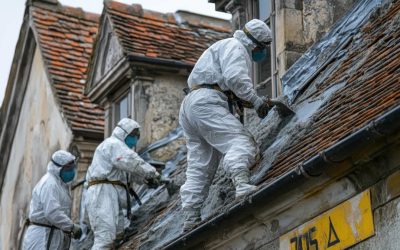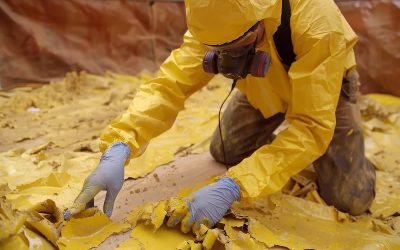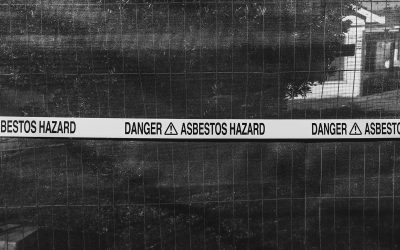If you’ve ever heard someone mention an asbestos register and thought, “What exactly is that?” — you’re not alone. It’s one of those things that’s really important, but often, no one explains it in a way that actually makes sense. So, let’s break it all down properly. No jargon, no complicated language, just clear information you can actually use.
By the end of this, you’ll know what an asbestos register is, why you might need one, what should go in it, and how you can make sure yours is up to scratch.
So, What Exactly Is an Asbestos Register?
An asbestos register is basically a document that lists all the asbestos that’s been found — or might be present — in a building. Think of it as a map or a guide. It tells you:
- Where asbestos is located.
- What condition it’s in.
- What type of asbestos it is (if known).
It’s there to keep people safe. If builders, maintenance workers, or even cleaners know exactly where asbestos is, they can avoid disturbing it. Because when asbestos gets damaged, the tiny fibres it releases can be deadly if breathed in.
Why Do You Need an Asbestos Register?
You might wonder, “Why do I even need one?” It’s a fair question. Here’s the thing: under the law, if you’re responsible for managing a building (whether you own it, lease it, or just manage it), you have a legal duty to manage asbestos properly. That duty is spelled out in the Control of Asbestos Regulations 2012.
Part of managing asbestos means knowing where it is. And that’s where the register comes in. Without a register, you can’t say you’re properly managing the risk.
An asbestos register helps you:
- Protect people who work in or visit the building.
- Plan maintenance or renovation work safely.
- Avoid unexpected costs if asbestos is found during building work.
- Stay on the right side of the law.
If you don’t have one, and asbestos causes harm, you could be fined heavily — or worse. So it’s not something you want to take lightly.
Who Needs an Asbestos Register?
You’ll need an asbestos register if:
- Your building was built before the year 2000.
- You manage, own, lease, or control any part of a non-domestic building.
- You’re carrying out building work on an older residential building.
It doesn’t matter if you think there’s no asbestos. If the building was put up before 2000, you must assume asbestos could be there unless you can prove otherwise.
For residential properties, it’s a bit different. If you’re just living in your own home, you don’t have a legal duty to have a register. But if you rent out a property, or you manage shared spaces like stairwells or hallways, then you do.
What Should Go Into an Asbestos Register?
Your asbestos register isn’t just a random list. It’s a working document that should include a few key bits of information:
- A clear description of the building or site. You should set out which areas have been inspected.
- Details of asbestos found. This means what type, where it is, and what condition it’s in.
- Presumed asbestos. If an area hasn’t been inspected — say it was unsafe to get to — you need to assume asbestos could be there and record that in the register.
- Details of sampling or lab analysis. If you’ve had samples tested, you should include the results.
- Photographs or plans. These help to show exactly where asbestos is.
- Any action taken. For example, if asbestos was removed or repaired, that should be recorded.
An asbestos register should be easy to understand. It’s no good if it’s so complicated that nobody knows what it’s saying. Remember, the people who need to use it might not be asbestos experts — they could be builders, decorators, electricians, or even cleaners.
How Do You Create an Asbestos Register?
To create a register, you first need an asbestos survey. Not just any survey, though — you need a proper management survey carried out by someone who knows what they’re doing.
The surveyor will inspect the building, take samples if needed, and then write a report. From that report, you can pull together your asbestos register.
You can also pay for a professional to create the register for you. That’s often a good idea, especially if you’re not sure how to do it yourself.
Keeping the Asbestos Register Up to Date
It’s not enough just to create a register and forget about it. You need to keep it updated.
Every time you:
- Have maintenance or building work done,
- Remove or repair asbestos,
- Inspect the building,
you need to update the register.
The law expects you to treat it as a “living document”. That means it should change as the building changes. If new asbestos is found, or old asbestos is removed, the register must reflect that.
You should also review the register regularly — at least once a year. Even if nothing has changed, it’s a good idea to check that the asbestos you know about is still in the same condition and hasn’t started to deteriorate.
What Happens If You Don’t Have an Asbestos Register?
If you don’t have an asbestos register when you’re legally meant to, you’re putting yourself and others at serious risk.
Here’s what could happen:
- Workers could accidentally disturb asbestos without knowing it’s there.
- People could be exposed to dangerous fibres.
- You could be fined heavily.
- You could face legal action if someone is harmed.
- Your insurance might not cover you.
The Health and Safety Executive (HSE) takes asbestos management seriously. They carry out inspections, and if they find you’re not complying, they can issue enforcement notices or even prosecute.
In short: it’s just not worth the risk.
How to Manage Your Asbestos Register Properly
Once you’ve got your asbestos register, you need to make sure it’s being managed properly. Here’s how you can stay on top of it:
- Keep it easily accessible. Anyone who might disturb the fabric of the building should be able to see it.
- Update it after any work. If you have repairs, maintenance, or upgrades done, review the register.
- Re-inspect regularly. Arrange annual checks to see if the asbestos condition has changed.
- Train your staff. If you have employees who work in the building, make sure they know about the asbestos risks.
- Use professional help if needed. Sometimes it’s better to get expert support, especially for complicated buildings.
The register is only useful if it’s kept up to date and shared with the right people.
Common Mistakes People Make With Asbestos Registers
It’s easy to make mistakes if you’re not familiar with asbestos management. Here are a few common ones to watch out for:
- Thinking a survey alone is enough. The survey gives you information, but you still need to pull it together into a register.
- Only recording tested materials. You must also include presumed asbestos where sampling wasn’t possible.
- Not reviewing regularly. Asbestos condition can change over time. If you don’t check, you won’t know.
- Locking the register away. It needs to be available to anyone who might disturb the building’s materials.
- Ignoring shared spaces. If you manage a block of flats, communal areas still count.
Avoiding these mistakes will make a huge difference in keeping everyone safe and meeting your legal responsibilities.
What’s the Difference Between an Asbestos Survey and an Asbestos Register?
It’s easy to get confused between an asbestos survey and an asbestos register, but they’re not the same thing.
- The survey is the process where someone inspects the building to find asbestos.
- The register is the document that lists what was found, where it is, and what’s been done about it.
You use the survey to create the register. Then, you keep the register updated over time. If you just have the survey report sitting on a shelf somewhere, that’s not enough.
Final Thoughts
An asbestos register isn’t just a bit of red tape. It’s a crucial part of keeping people safe. It shows you’re taking your responsibilities seriously, and it helps prevent deadly exposure to asbestos fibres.
If you’re responsible for a building — whether it’s an office, a shop, a school, or even a block of flats — and it was built before 2000, you need to have a register.
Make sure it’s clear, easy to use, and kept up to date. And remember, you’re not just protecting yourself legally — you’re protecting lives.
If you’re unsure where to start, speak to a professional asbestos surveyor. They can guide you through the process, so you can feel confident you’ve covered everything.
Stay safe, stay informed, and make sure your asbestos register does what it’s supposed to — keeping everyone protected.
Are you looking for Asbestos Disposal in Buckinghamshire? If so, contact us now!
Asbestos Removal Edgware – Asbestos Removal West Brompton – Asbestos Removal Willesden










